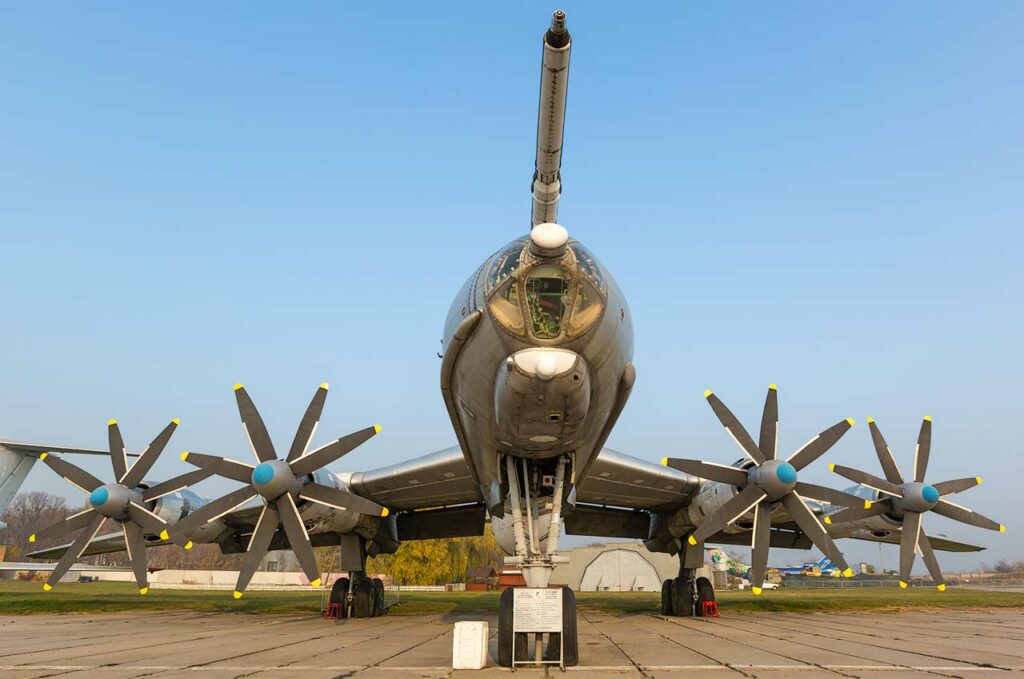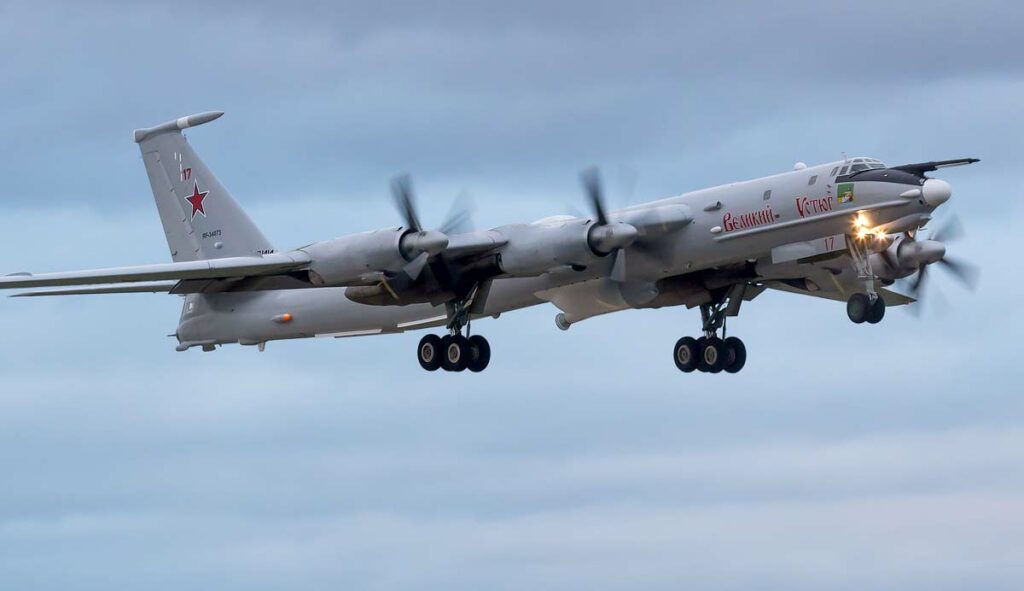The Tupolev Tu-142 Bear is a long-range maritime reconnaissance and anti-submarine warfare aircraft.
In brief
The Tupolev Tu-142 Bear, derived from the Tu-95 strategic bomber, is a maritime reconnaissance and anti-submarine warfare (ASW) aircraft. Introduced in the late 1960s by the Soviet Union, it was designed to operate over vast oceanic territories, tracking and engaging enemy submarines. The Tu-142 is notable for its large, swept wings, four turboprop engines with contra-rotating propellers, and a distinctive, slender fuselage. Capable of flying over 8,000 miles without refueling and reaching speeds of up to 575 mph, its endurance and speed make it one of the most formidable platforms in its class. Equipped with a variety of sensors, magnetic anomaly detectors, and weapons for ASW roles, the Tu-142 has been updated over the decades to improve its capabilities in electronic warfare and surveillance.
The Tupolev Tu-142 Bear has been a cornerstone of Soviet and Russian naval aviation for over five decades, serving as a key asset in anti-submarine warfare and reconnaissance operations over the world’s oceans. Its development was driven by the necessity of countering the growing threat of Western naval capabilities, particularly the ballistic missile submarines that could evade traditional maritime patrol assets.

History of the Development of the Tupolev Tu-142 Bear
In the context of the Cold War’s naval arms race, the Soviet Union sought to expand its maritime surveillance and strike capabilities. The Tu-142 was developed to meet this need, building on the successful Tu-95 strategic bomber design. The program, initiated by the Tupolev design bureau, aimed to create an aircraft capable of long-endurance missions over open water, detecting and engaging enemy submarines from great distances. The Tu-142 first flew in 1968, incorporating advanced avionics, sensors, and weapons systems tailored for maritime operations. Its NATO nickname, “Bear,” became synonymous with the extended reach of Soviet naval aviation.
Design of the Tupolev Tu-142 Bear
The design of the Tu-142 Bear focused on maximizing range, endurance, and payload capacity. With a wingspan of 164 feet and a length of 162 feet, its large frame houses an extensive suite of navigation and targeting systems, including radar, sonobuoys, and magnetic anomaly detectors. The aircraft’s four Kuznetsov NK-12MP turboprop engines, the most powerful of their kind, enable it to achieve high subsonic speeds and operate at altitudes up to 39,000 feet, with a range that surpasses most competitors.
Despite its capabilities, the Tu-142’s size and turboprop propulsion system limit its maneuverability and speed compared to jet-powered counterparts. However, these characteristics are optimal for its role in ASW and reconnaissance, where loitering ability and sensor integration are paramount.
Performance of the Tupolev Tu-142 Bear
The Tu-142’s performance in its designated roles has been exemplary, with the ability to cover vast areas of ocean during its missions. Its maximum speed of around 575 mph and an operational range of over 8,000 miles without refueling allow it to deploy quickly to distant operational theaters. The aircraft’s endurance and comprehensive sensor package enable it to detect and track submarines under challenging conditions, providing a strategic advantage in naval warfare.
When compared to Western ASW aircraft like the P-3 Orion or the P-8 Poseidon, the Tu-142 offers greater range and payload capacity, though it may lack some of the advanced technologies and efficiencies of newer turbofan-powered aircraft.
Variants of the Tupolev Tu-142 Bear
Several variants of the Tu-142 have been developed to enhance its capabilities and adapt to evolving technological and strategic landscapes. These include the Tu-142MZ, the most modern version, with improved avionics, communications, and weapon systems. Each variant has contributed to extending the operational life and effectiveness of the Tu-142 fleet, ensuring its relevance in contemporary maritime security operations.

Military Use and Combat of the Tupolev Tu-142 Bear
While not directly engaged in kinetic combat operations, the Tu-142 has played a crucial role in maritime security and deterrence. Its missions have spanned from tracking NATO naval movements during the Cold War to participating in modern-day exercises and operations. The aircraft’s ability to carry anti-ship missiles and torpedoes, along with its extensive reconnaissance capabilities, make it a versatile asset in projecting power and conducting surveillance over strategic maritime areas.
The Tu-142 has been operated primarily by Soviet and Russian naval aviation, with India also operating a variant for its maritime patrol requirements. Despite its age, the Tu-142 continues to be a valuable component of Russia’s military aviation assets, with upgrades ensuring its operational viability well into the future.
Recap
The Tupolev Tu-142 Bear stands as a testament to the enduring importance of maritime reconnaissance and anti-submarine warfare capabilities in global security. Its development and operational history reflect the strategic priorities of naval power projection and the continuous evolution of military aviation technology. As one of the longest-serving aircraft in its class, the Tu-142’s legacy is characterized by its remarkable endurance, versatility, and contribution to the strategic balance of naval air power.
Back to the Bombers section.